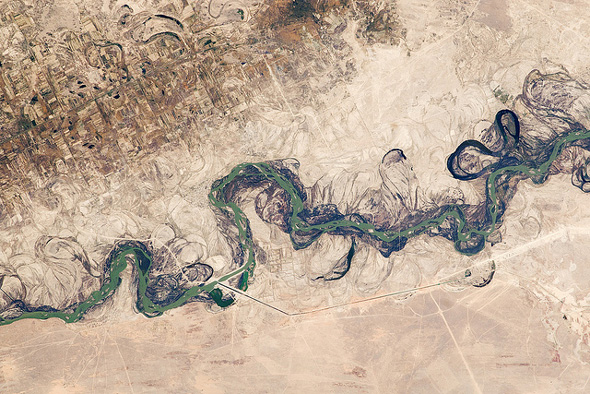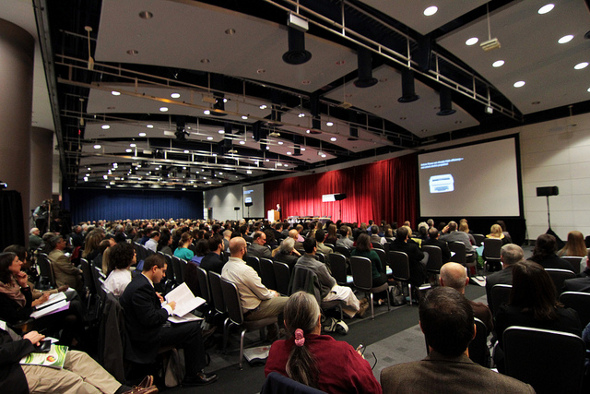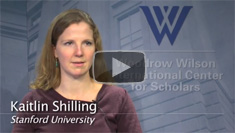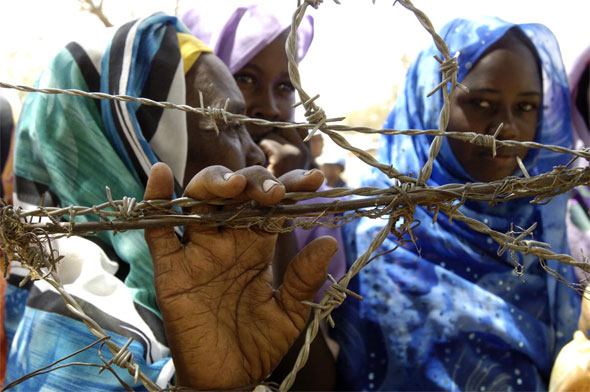-
Global Water Security Calls for U.S. Leadership, Says Intelligence Assessment
›March 26, 2012 // By Schuyler Null
Alongside and in support of Secretary Clinton’s announcement of a new State Department-led water security initiative last week was the release of a global water security assessment by the National Intelligence Council and Director of National Intelligence. The aim of the report? Answer the question: “How will water problems (shortages, poor water quality, or floods) impact U.S. national security interests over the next 30 years?”
-
Eelke Kraak, ChinaDialogue
Central Asia’s Dam Debacle
›March 13, 2012 // By Wilson Center StaffThe original version of this article, by Eelke Kraak, appeared on ChinaDialogue.
The Toktogul Dam in Kyrgyzstan is an imposing structure. The dam guards the largest and only multi-annual water reservoir in central Asia. The cascade of five hydroelectric stations downstream produces 90 percent of Kyrgyzstan’s power. Cotton fields thousands of kilometers away in Kazakhstan and Uzbekistan depend on the release of water from this dam.
The Toktogul is literally and figuratively the “valve” of the Syr Darya River. But by relying on large-scale engineering projects to control the river, these countries have ignored the fundamentally political nature of water management.
The significance of the Toktogul dam goes beyond its economic benefits. It was the center piece of the Soviet Union’s efforts to conquer nature in its drive to modernize central Asia. When it became fully operational in the late 1980s, the project to control the region’s rivers seemed complete.
But the costs have been high. The Aral Sea, the terminal lake of the main sources of water in central Asia, the Syr Darya and Amu Darya rivers, has shrunk to almost nothing. Many areas surrounding what is left of the lake are heavily polluted. Moreover, the now independent Syr Darya riparian countries – Kyrgyzstan, Uzbekistan, Tajikistan and Kazakhstan – disagree on how the Toktogul should be operated.
Continue reading on ChinaDialogue.
Syr Darya River Floodplain, Kazakhstan, courtesy of NASA and the Center for Philosophy of Sciences of the University of Lisbon. -
Geoff Dabelko on Finding Common Ground Among Conservation, Development, and Security at the 2011 WWF Fuller Symposium
› Bridging the divide between the conservation and security communities “requires that we check some stereotypes at the door,” said ECSP’s Geoff Dabelko at the World Wildlife Fund’s Conservation Forward: Ideas That Work and How Science Can Effect Change symposium. Changes in global climate, as well as environmental threats more local in origin, require us to “find ways to minimize threats [and] maximize opportunities…from the dialogue between these different communities – and get out of our silos to do that,” said Dabelko.
Bridging the divide between the conservation and security communities “requires that we check some stereotypes at the door,” said ECSP’s Geoff Dabelko at the World Wildlife Fund’s Conservation Forward: Ideas That Work and How Science Can Effect Change symposium. Changes in global climate, as well as environmental threats more local in origin, require us to “find ways to minimize threats [and] maximize opportunities…from the dialogue between these different communities – and get out of our silos to do that,” said Dabelko.
However, this dialogue faces real challenges and concrete trade-offs. “There are big imbalances in terms of the resources that these different communities have,” and this often cuts the conversation short, he said. The conservation and security communities are also orientated towards some very different objectives and toolsets. But “given the levels of stress that our natural systems are under, given the level of dysfunction that are political systems are exhibiting, to me, it suggests that it’s a call for all hands on deck,” asserted Dabelko.
“The relationship between environment, natural resources, and violent conflict” is not the “only part of the story,” he said. Conservation goals can be achieved by preserving biodiversity on military sites and demilitarized zones, and through the Department of Defense’s new focus on reducing energy consumption. In the past, Russian-Norwegian-U.S. cooperation around de-commissioning Soviet-era nuclear submarines protected fragile Arctic habitats, prevented potentially dangerous technology from reaching world markets, and built confidence between recent adversaries. The dual potentials of “peace parks” in fragile and insecure borders across the Middle East have also garnered attention.
Environmental Peacebuilding
“Too often…natural resources are viewed as luxury items – what you worry about once you get rich, democratic, and peaceful,” yet, the environment is an “essential ingredient” for peace, Dabelko said. It is often “key to restoring livelihoods and jump-starting the economy” in conflict affected countries.
“Under a rubric or umbrella that we’re calling ‘environmental peacebuilding’ we have systematic efforts to…break those links with conflict,” he said. The future “concern is that because of environmental change, growth in population, growth in consumption,” and rampant inequities, climate change will act as a “threat multiplier.” “A risk analysis frame” is required to think through not only the risk of failing to act but also the risk of acting in ways that have the potential to create conflict if done poorly.
“We’re talking about changing access to resources and introducing money into uncertain political contexts – who gets it for what. That can be done well and that can be done poorly, and if you are talking to the folks in the conflict community, that’s often an inflection point for when conflict is a potential,” Dabelko said. In the context of potentially troublesome adaptations such as biofuel production, hydropower projects, and REDD+, this means taking seriously the well-worn, but apt, mantra of “do no harm” and working to maximize the “triple bottom line” of development, peace, and climate stability.
A question and answer period, moderated by USAID’s Cynthia Gill, followed the presentation with fellow speakers Anne Salomon of Fraser University, Michael Jenkins of Forest Trends, and Martin Palmer from the Alliance of Religions and Conservation (available below). -
Integration, Communication Across Sectors a Must, Say Speakers at 2012 NCSE Environment and Security Conference (Updated)
›February 23, 2012 // By Wilson Center StaffECSP staff were among the more than 1,000 attendees discussing non-traditional security issues at the 12th National Conference on Science, Policy, and the Environment last month at the Ronald Reagan Building. Our own Geoff Dabelko spoke on the opening plenary (above) and we collected other excerpts below, though they’re only a small slice of the conference. Find our full coverage by following the NCSE tag, see the full agenda on environmentalsecurity.org, and follow the conversation on Twitter (#NCSEconf).
Climate, Energy, Food, Water, and Health
At the conference’s lead-off plenary, Jeff Seabright (Vice President, The Coca-Cola Company), Daniel Gerstein (Deputy Under Secretary for Science and Technology, U.S. Department of Homeland Security), Rosamond Naylor (Director, Stanford’s Center on Food Security and Environment), and our ECSP’s Geoff Dabelko highlighted the challenges and opportunities of addressing the diverse yet interconnected issues of climate, energy, food, water, and health.
“We need to embrace diversity regardless of the complexity,” said Dabelko, and “abandon our stereotypes and get out of our stovepipes.” Government agencies, academics, and NGOs must be open to using different tools and work together to capture synergies. “If we know everyone in the room, we are not getting out enough,” he said.
“We have to be concerned with every level – national, state, tribal, regional, down to the individual,” said Gerstein. DHS recognizes that climate change affects all of its efforts, and has established three main areas of focus: Arctic impacts; severe weather; and critical infrastructure and key resources.
For Coca-Cola, “managing the complex relationship among [food, water, and energy] is going to be the challenge of the 21st century, said Seabright, who noted that the business community is “seeing a steady increase in the internalization of these issues into business,” including as part of companies’ competitive advantages and strategies.
Similarly, we must offer opportunities and not just threats, said Dabelko, such as exploring climate adaptation’s potential as a tool for peacebuilding rather than simply focusing on climate’s links to conflict. We need to “find ways to define and measure success that embrace the connections among climate, water, and energy, and does not try to pretend they aren’t connected in the real world,” he said.
Communicating Across Sectors: Difficult But Necessary
Next, Sherri Goodman (Executive Director, CNA Military Advisory Board), Nancy Sutley (Chair, White House Council on Environmental Quality), Rear Admiral Neil Morisetti (Climate and Energy Security Envoy, UK Ministry of Defence), and Susan Avery (Director, Woods Hole Oceanographic Institute) called on governments, militaries, and institutions to move away from traditional, vertically segmented responsibilities to address today’s environmental and security challenges.
“We live in an interdependent, connected world,” Morisetti said, but communicating that is a challenge. Militaries are likely to have new, broader missions, including conflict prevention, he said, which makes communications all the more important.
Science is moving from reductive to integrated outlooks to better address larger, systems-wide challenges, said Avery, but communicating results of this research to the public, and across and between disciplines, is difficult.
Confronting these communication and education challenges, particularly the difficulties of conveying the probability of various risks, is a key focus of the Council on Environmental Quality, said Sutley. “We confront the challenge of risk communication every day and it’s not limited to climate change,” she said.Challenging Conventional Wisdom on Climate and Conflict
The common argument is that climate change will lead to scarcity – less arable land, water, rain, etc. – and scarcity will lead to conflict, said Kate Marvel (Lawrence Livermore National Lab). But the link between scarcity and conflict is not that clear. It’s “very important to treat models as tools, not as magic balls,” she said. Developing better diagnostics to test models will help researchers and observers sort out which ones are best.
Kaitlin Shilling (Stanford University) called on the environmental security community to move beyond simple causal pathways towards finding solutions. After all, rolling back climate change is not an option at this point, she said; to find solutions, therefore, we need more detailed analysis of the pathways to violence.
The most common types of climate-conflict correlations are not likely to directly involve the state, said Cullen Hendrix (College of William and Mary). Traditional inter-state wars (think “water wars”) or even civil wars are much less likely than threats to human security (e.g., post-elections violence in Kenya) and community security (e.g., tribal raiding in South Sudan). For this reason, the biggest breakthroughs in understanding climate and conflict links will likely come from better interactions between social and physical scientists, he said.
Because the many unique factors leading to conflict vary from place to place, a better way to assess climate-conflict risk might be mapping human vulnerability to climate change rather than predicting conflict risk in a given place, said Justin Mankin (Stanford University). While human reactions are very difficult to predict, vulnerability is easier to quantify.
Yu Hongyuan (Shanghai Institute for International Studies) compared the concerns of U.S. and Chinese officials on climate change. Polling results, he said, show Chinese officials are most concerned with maintaining access to resources, while American policymakers focus on climate change’s effects on global governance and how it will impact responses to natural disasters, new conflicts, and humanitarian crises. Given the centrality of these two countries to international climate negotiations, Yu said he hoped the “same issues, different values” gulf might be bridged by better understanding each side’s priorities.
Schuyler Null, Lauren Herzer, and Meaghan Parker contributed to this article.
Video Credit: Lyle Birkey/NCSE; photo credit: Sean Peoples/Wilson Center. -
Kaitlin Shilling: Climate Conflict and Export Crops in Sub-Saharan Africa
› “There’s been a tremendous amount of work done on looking for a climate signal for civil conflict, particularly in sub-Saharan Africa, and a lot of this work draws a very clear and simple path – if it rains more, or if it rains less, there will be more or less conflict,” says Stanford University’s Kaitlin Shilling in this short video interview. Unfortunately, that straightforward research does little in the way of helping policymakers: “the only way to change the agricultural outputs due to climate change is to change climate change, reduce climate change, or stop it,” she says, “and we’re not really good at that part.”
“There’s been a tremendous amount of work done on looking for a climate signal for civil conflict, particularly in sub-Saharan Africa, and a lot of this work draws a very clear and simple path – if it rains more, or if it rains less, there will be more or less conflict,” says Stanford University’s Kaitlin Shilling in this short video interview. Unfortunately, that straightforward research does little in the way of helping policymakers: “the only way to change the agricultural outputs due to climate change is to change climate change, reduce climate change, or stop it,” she says, “and we’re not really good at that part.”
Shilling moderated a panel at last month’s National Conference on Science, Policy, and the Environment on climate-conflict research. Agricultural export crops – cotton, coffee, cocoa, tea, vanilla – represent one area where policymakers might be able to intervene to prevent climate-driven conflict, says Shilling. Though not as important from a food security perspective, “these crops are really important” for sub-Saharan economies, as well as for “government revenues, which [are] closely related to government capacity.”
But “the effects of climate change on those crops are less well understood,” Shilling says. How they relate to “government revenues and how those relate to civil conflict is an area that I spend a lot of time doing research on.”
By “understand[ing] the mechanisms that underlie the potential relationship between climate and conflict, we can start identifying interventions that make sense to reduce the vulnerability of people to conflict and help them to adapt to the coming climate change.” -
The Ramsar Convention: A New Window for Environmental Diplomacy?
›In seeking ways to connect conservation with peacemaking, the Institute for Environmental Diplomacy and Security (IEDS) has released a study that examines an expanded role for the international wetlands treaty, the Ramsar Convention.
The Ramsar Convention: A New Window for Environmental Diplomacy? describes the wetlands convention, its place within the international environmental treaty world, and its potential to enhance environmental security during this dynamic time of increasingly insecure water supplies and climate change. With more than 40 years of work, the treaty has been quietly and effectively conserving wetlands and increasing recognition of the need to build international cooperation around them. The treaty has also helped define wetlands within greater biogeographic regions and led to formal identification of transboundary wetlands.
In the article, we set out to combine information from the convention’s 234 listed wetlands (13 of which have formal transboundary plans) with the Global Peace Index, which ranks countries using 23 indicators, such as number of conflicts, conflict deaths, military expenditures, and relations with neighboring countries. The result is a prioritized list of countries most in need of tools of conflict resolution.
Working within the framework of the convention builds capacity between high-conflict-risk nations and has potential to develop otherwise-difficult-to-establish trust because the process is transparent and all stakeholder voices are heard. This can be important even when the existing conflict has nothing to do with international wetlands.
The convention is active in many countries with ongoing conflicts, such as Afghanistan, the Democratic Republic of the Congo, Iran, Iraq, and Sudan, and efforts there may help inform the ongoing debate as to the efficacy of conservation as a tool for peacemaking.
As environmental conditions continue to evolve rapidly, the need for institutions that can work in the transboundary environment will increase. The established international infrastructure of the convention has the potential to be a greater force in peacemaking. Further research may help focus on the strengths and weaknesses of the current system and reveal ways for more effective peacemaking efforts.
Suggestions for ways to enhance the convention’s role in environmental diplomacy include working more closely with researchers and practitioners directly involved in the environmental peacemaking field, increased focus on developing capacity for increased flexibility to react to dynamic conditions, and more active promotion of formal transboundary agreements.
Pamela Griffin is an independent scholar at IEDS where she focuses on the diplomatic potential of transboundary wetlands. -
Taking a Livelihoods Approach to Understanding Environmental Security
›February 17, 2012 // By Kate DiamondSince the concept of “environmental security” first gained traction in the early 1990s, research on the issue has been overwhelmingly focused on how environmental change impacts state security. That has been to the detriment of policymakers trying to preempt instability and conflict, according to the University of Toronto’s Tom Deligiannis in his article, “The Evolution of Environment-Conflict Research: Toward a Livelihood Framework,” published in February’s Global Environmental Politics.
-
‘Dialogue TV’ With Sharon Burke, Neil Morisetti, and Geoff Dabelko: Climate, Energy, and the Military
›We are entering “an emerging security environment” where “what constitutes a ‘threat’ and what constitutes a ‘challenge’” requires a broader understanding of security than has often been the norm, according to Sharon Burke, Assistant Secretary of Defense for Operational Energy Plans and Programs. Burke was joined by the UK’s Climate and Energy Security Envoy Rear Admiral Neil Morisetti and ECSP’s Geoff Dabelko on a new installment of Dialogue TV. They debated what climate change and energy security mean for the world’s militaries.
Showing posts from category environmental security.










